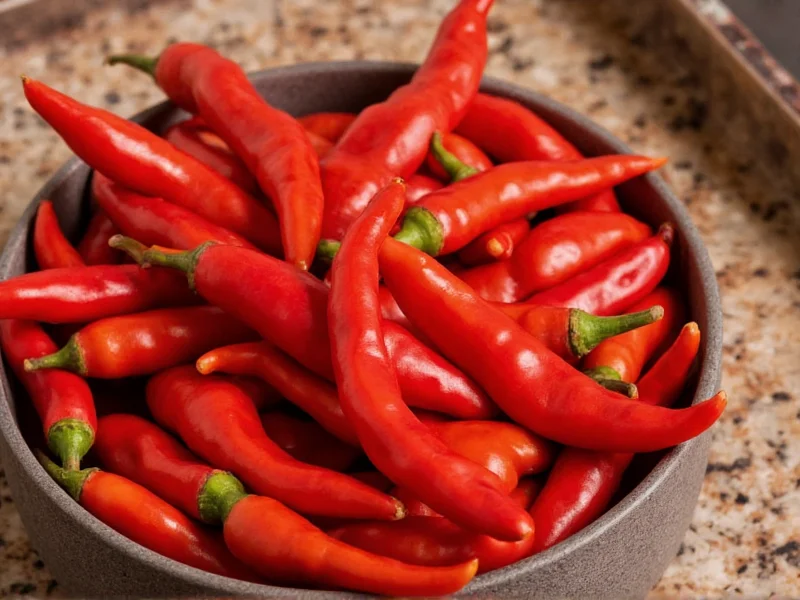Understanding just how hot is Bhut Jolokia requires context beyond raw numbers. The Scoville scale, developed by pharmacist Wilbur Scoville in 1912, measures capsaicin concentration—the compound responsible for chili heat. While most supermarket jalapeños register 2,500-8,000 SHU, the Bhut Jolokia's heat intensity places it in the realm of serious chili enthusiasts and requires careful handling.
Scientific Verification of Bhut Jolokia Heat Levels
Researchers at New Mexico State University's Chile Pepper Institute conducted rigorous testing that confirmed the Bhut Jolokia's extraordinary heat. Their 2006 study, which led to the Guinness World Record certification, measured samples from multiple plants grown under controlled conditions. The consistent results across different specimens validated its status as the hottest pepper at that time.
The heat measurement process involves high-performance liquid chromatography (HPLC), a modern method that provides more accurate readings than the original Scoville taste test. This scientific approach eliminates subjectivity and delivers precise capsaicinoid measurements that translate to the familiar Scoville scale.
Comparing Bhut Jolokia Heat to Common Peppers
| Pepper Variety | Scoville Heat Units (SHU) | Heat Comparison to Bhut Jolokia |
|---|---|---|
| Bhut Jolokia (Ghost Pepper) | 855,000-1,041,427 | 1x (baseline) |
| Habanero | 100,000-350,000 | 2-8x milder |
| Cayenne | 30,000-50,000 | 17-35x milder |
| Serrano | 10,000-23,000 | 37-104x milder |
| Jalapeño | 2,500-8,000 | 107-416x milder |
| Bell Pepper | 0 | Infinitely milder |
Practical Implications of Bhut Jolokia's Extreme Heat
When exploring how hot is Bhut Jolokia pepper in practical terms, consider these important factors:
- Physical effects: Consuming Bhut Jolokia can cause immediate burning sensation, sweating, and temporary difficulty breathing. The effects typically peak within 5-10 minutes and can last for 30-45 minutes.
- Safety precautions: Always wear gloves when handling Bhut Jolokia peppers. Avoid touching your face, especially eyes, as capsaicin can transfer and cause severe irritation.
- Culinary applications: Professional chefs use Bhut Jolokia sparingly—often just a few drops of infused oil rather than the whole pepper. It's commonly found in hot sauces, specialty curries, and as a dare in eating challenges.
- Neutralizing the burn: Dairy products like milk or yogurt provide the most effective relief due to casein's ability to break down capsaicin. Water merely spreads the oil, intensifying the burn.
Common Misconceptions About Bhut Jolokia Heat
Several myths persist about how hot is Bhut Jolokia compared to other super-hot peppers:
Myth: The seeds contain most of the heat.
Reality: Capsaicin is primarily concentrated in the white pith (placenta) surrounding the seeds, not the seeds themselves.
Myth: Bhut Jolokia is still the world's hottest pepper.
Reality: While it held the Guinness World Record from 2007-2011, several peppers including the Carolina Reaper and Pepper X now exceed its heat level.
Myth: All Bhut Jolokia peppers have identical heat levels.
Reality: Heat varies significantly based on growing conditions, soil composition, and climate—sometimes differing by as much as 200,000 SHU between specimens from the same plant.
Scientific Research on Bhut Jolokia Applications
Beyond culinary curiosity about how hot is Bhut Jolokia, researchers have explored practical applications of its intense capsaicin content:
- Medical research: Studies investigate capsaicin's potential for pain management, particularly for conditions like arthritis and neuropathy.
- Defense applications: The Bhut Jolokia's heat has been used to develop non-lethal deterrents, including the Indian military's chili grenade.
- Agricultural benefits: Farmers in Northeast India traditionally used Bhut Jolokia to deter elephants from crops—a practice still employed today.
Responsible Consumption Guidelines
If you're considering experiencing Bhut Jolokia's heat firsthand, follow these safety recommendations:
- Start with minuscule amounts—less than 1/8 teaspoon of prepared product
- Have dairy products readily available for immediate relief
- Avoid consumption on an empty stomach
- Never consume Bhut Jolokia without experienced supervision
- Consult a physician if you have gastrointestinal conditions
Understanding exactly how hot is Bhut Jolokia helps enthusiasts appreciate both its culinary potential and necessary precautions. While its record-breaking status has been surpassed by newer cultivars, the Bhut Jolokia remains a benchmark for extreme heat that demands respect from growers, chefs, and consumers alike.
Frequently Asked Questions
How does Bhut Jolokia compare to the Carolina Reaper?
The Carolina Reaper typically measures 1,400,000-2,200,000 SHU, making it approximately 1.5-2 times hotter than the Bhut Jolokia's 855,000-1,041,427 SHU range. While Bhut Jolokia held the world record from 2007-2011, the Carolina Reaper surpassed it and currently holds the Guinness World Record for hottest chili pepper.
Can eating Bhut Jolokia be dangerous?
While consuming Bhut Jolokia isn't typically life-threatening for healthy adults, it can cause severe discomfort including intense burning, sweating, nausea, and temporary breathing difficulties. People with gastrointestinal conditions should avoid it completely. In rare cases, excessive consumption has led to gastric ruptures requiring medical attention. Always consume super-hot peppers with caution and have dairy products available for relief.
Why does milk help with Bhut Jolokia burn?
Milk contains casein, a protein that binds to capsaicin (the compound causing the burning sensation) and helps wash it away from nerve receptors. The fat content in whole milk makes it particularly effective. Water doesn't work because capsaicin is oil-soluble, not water-soluble—water actually spreads the oil, intensifying the burn.
How should I handle Bhut Jolokia peppers safely?
Always wear nitrile or latex gloves when handling Bhut Jolokia peppers, and avoid touching your face. Work in a well-ventilated area as capsaicin can become airborne when cutting. Use separate cutting boards and utensils that won't be used for other foods. After handling, wash all surfaces with soapy water and dispose of gloves properly. Consider wearing safety glasses to protect your eyes from accidental exposure.
Does cooking reduce Bhut Jolokia's heat level?
Cooking doesn't significantly reduce Bhut Jolokia's heat because capsaicin is heat-stable up to temperatures around 400°F (204°C). However, when incorporated into dishes with fats, dairy, or sugars, the perceived heat can be moderated as these ingredients help bind and neutralize the capsaicin. The heat also distributes more evenly throughout the dish, making individual bites less intense than consuming the raw pepper.











 浙公网安备
33010002000092号
浙公网安备
33010002000092号 浙B2-20120091-4
浙B2-20120091-4